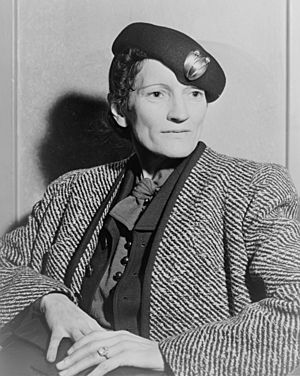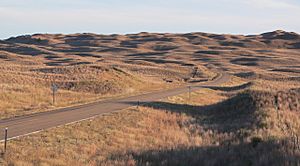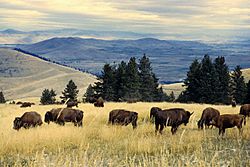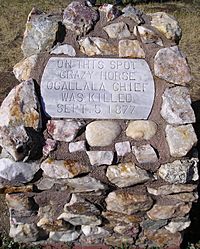Mari Sandoz facts for kids
Quick facts for kids
Mari Sandoz
|
|
|---|---|

Mari Sandoz, 1938
|
|
| Born |
Mary Susette Sandoz
May 11, 1896 Sandoz Post Office, Running Water Precinct, Sheridan County, Nebraska
|
| Died | March 10, 1966 (aged 69) |
| Education | |
| Parent(s) |
|
Mari Sandoz (born May 11, 1896 – died March 10, 1966) was an important American writer from Nebraska. She wrote many books, including novels and biographies. Her stories often focused on the lives of pioneers and Plains Indians in the American West. Mari Sandoz was also a teacher and a lecturer. She won the Newbery Medal for one of her books.
Contents
Early Life and Education
Mari Sandoz was born near Hay Springs, Nebraska. She was the oldest of six children. Her parents, Jules and Mary Elizabeth Sandoz, were immigrants from Switzerland. Her father was very strict and did not like her reading or writing.
Mari spent her childhood working hard on the family farm. One time, she spent a day digging cattle out of a snowdrift. This caused her to develop a problem with one of her eyes called snow blindness.
She finished eighth grade when she was 17. Without telling anyone, she took a test to become a rural teacher and passed. She taught in country schools nearby, even though she never went to high school herself.
When she was 18, Mari married a rancher named Wray Macumber. She was not happy in her marriage. In 1919, she divorced him and moved to Lincoln.
Starting Her Writing Career
For the next 16 years, Mari Sandoz worked many low-paying jobs. She spent her free time writing, but her stories were often rejected by publishers. Even though she didn't have a high school diploma, she managed to get into the University of Nebraska. A kind dean helped her enroll. During these years, she said she received more than a thousand rejection letters for her short stories.

In 1928, Mari learned her father was dying. She visited her family, and he asked her to write his life story. This request surprised her. She began a lot of research about his life. She wrote about his choice to become a pioneer, his hard work on the prairie, his leadership in the community, and his friendships with local Native Americans.
The book she wrote was called Old Jules. It was published under the name Mari Sandoz, which she started using again in 1929.
In 1933, Mari was not well and decided to move back home to the Sand Hills to stay with her mother. At this point, every major publisher in the United States had rejected Old Jules. Before leaving Lincoln, Mari burned over 70 of her old stories and manuscripts in her backyard.
But she kept writing. She started a new novel called Slogum House. This was a tough and realistic story about a powerful family in Nebraska. By January 1934, she returned to Lincoln. She got a job at the Nebraska State Historical Society, where she helped edit the Nebraska History magazine.
In 1935, Mari finally got good news. Her updated version of Old Jules won a non-fiction writing contest! This happened after it had been rejected 14 times. Before the book was published, she had to argue with her editor. Her publishers wanted her to change the unique Western way she had written the book. Mari fought to keep her original style.
When Old Jules was released, it was praised by critics and sold well. It even became a Book of the Month Club choice. Some readers were surprised because her book showed the Old West in a very real way, not a romantic one. They were also surprised by her strong language and how she showed the difficulties of frontier life.
Later Life and Works
In 1937, Mari Sandoz published Slogum House. This novel was set in the Sandhills and warned about the dangers of fascism. Some people criticized the book, and libraries in McCook and Omaha, Nebraska, even banned it in 1938.
Mari moved to New York City in 1943. She wanted to be closer to her publishers and have access to more research materials about the West.
In 1942, her important biography of the great Lakota leader Crazy Horse was published. It was called Crazy Horse: The Strange Man of the Oglalas. Mari was ahead of her time because she wrote the book from the Lakota point of view. She used Lakota ideas, comparisons, and even copied their way of speaking. Many critics believe this is her best work. In her introduction to Crazy Horse, she explained:
I have used the simplest words possible, hoping by idiom and figures and the under-lying rhythm pattern to say some of the things of the Indian for which there are no white-man words, suggest something of his innate nature, something of his relationship to the earth and the sky and all that is between.
Mari's careful research and her respect for the Plains Indian culture can also be seen in her later books. These include Cheyenne Autumn (1953), The Horsecatcher (1957), and The Story Catcher (1963).

She also wrote three other books in her Great Plains series. These books explored the history of the West through the story of different animals. They were The Buffalo Hunters (1954), The Cattlemen (1958), and The Beaver Men (1964). The Buffalo Hunters is one of her most famous works.
Mari Sandoz loved to help other writers. She led summer writing workshops at places like the University of Wisconsin–Madison. She also reviewed stories sent to her by new writers and gave them helpful advice. She even taught creative writing on television. She often told writers to "pick a subject you know well, and write about it." Mari kept writing almost until her death from bone cancer in 1966.
She asked to be buried south of Gordon, Nebraska. Her grave is on a hillside that looks out over her family's Sandhills ranch.
A statue of Mari Sandoz is displayed in the Nebraska State Capitol as part of the Nebraska Hall of Fame. There is also a special marker where she lived while writing Old Jules.
Awards and Recognition
- 1950 - Received an honorary Doctorate of Literature from the University of Nebraska.
- 1954 - Won the Distinguished Achievement Award for her honest portrayal of Nebraska.
- 1958 - Awarded the John Newbery Medal for her book The Horsecatcher.
- 1963 - Won the Spur Award for best Juvenile fiction for The Story Catcher.
- 1964 - Received the Saddleman Award (now called the Owen Wister Award) for The Story Catcher.
- 1969 - The Mari Sandoz Award was created by the Nebraska Library Association. It is given each year to someone who has made a big contribution to Nebraska's books through writing or film.
- 1975-76 - She was added to the Nebraska Hall of Fame.
- 1998 - She was inducted into the Hall of Great Westerners at the National Cowboy & Western Heritage Museum.
Books by Mari Sandoz
Non-fiction Books
- Old Jules. (1935)
- Crazy Horse: The Strange Man of the Oglalas. (1942)
- Cheyenne Autumn (book). (1953)
- The Buffalo Hunters. (1954)
- The Cattlemen: From the Rio Grande Across the Far Marias. (1958)
- Son of the Gamblin' Man: The Youth of an Artist. (1960)
- These Were the Sioux. (1961)
- Love Song to the Plains. (1961)
- The Beaver Men, Spearheads of Empire. (1964)
- The Battle of the Little Bighorn. (1966)
Fiction Books
- Slogum House. (1937)
- Capital City. (1939)
- The Tom-Walker. (1947)
- Winter Thunder. (1954)
- Miss Morissa: Doctor of the Gold Trail. (1955)
- The Horsecatcher. (1957)
- The Story Catcher. (1963)
Images for kids
Additional Resources
- The Mari Sandoz Heritage Society
- Publications by and about Mari Sandoz in the catalogue Helveticat of the Swiss National Library
See also
 In Spanish: Mari Sandoz para niños
In Spanish: Mari Sandoz para niños






